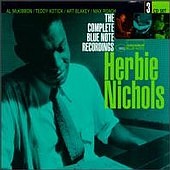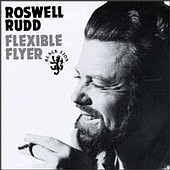Crumbling the Antiseptic Beauty | |

| Hear Herbie Nichols. Here is Herbie Nichols. Herbie's On Fire. All imaginary titles for lp's which the great jazz pianist never managed to record- the few which did emerge in his lifetime included the uncannily titled two volumes of The Prophetic Herbie Nichols. If George Shearing was God for Sal Paradise and the other searing soul-searching adventurers of On the Road, then the surges of invention and mesmerizing audacity of Nichols' playing secure his own presence as a Moses of sorts leading the open-minded listener into a musical Promised Land. I can't remember where I first came across the name. Possibly in Spellman's book Four Lives in the Bebop Business, where his write-up is overshadowed by the more familiar artillery of Cecil, Ornette and Jackie McLean. Which conforms to the pattern of the man's life in a lot of ways. Yet names have a way of creeping up on you, buzzing at the periphery of your consciousness and finally biting. So I felt the urge to explore this Herbie's bug, and went back and discovered more than I'd given credit for. The Nichols story is one of the most relentlessly downbeat I've come across in jazz history, all the more so for it being unmarked by bruising encounters with dope, alcohol or any of the myriad other vices which would afflict his peers. Throughout his life he'd perform piano accompaniment for other names, some short-lived meteors about to crash and burn, others slowly working their way up. All the while he'd deliver the goods, take his payment and shuffle off home, with jagged fragments of the old-time New Orleans dixieland he'd been called upon to pump out merging with the ringing tones of his own musical visions, oblique, transient, elliptical. Mysterious enough to aspire to the condition of cigarette smoke, robust enough to suggest nocturnal confusion, combustible, riffing on primitive source material. Not effete but combining technical precision with structures which accommodate angular interplay at its most daring. Clean, dazzlingly articulated personal expressions of a complex state of mind, filtered through revelatory ensemble playing with the likes of Art Blakey and Max Roach. The 3-cd box set of the complete Herbie Nichols recordings for Blue Note sets the matter to rights by restoring his series of 10" lps from the mid-50's to circulation, along with all known alternate takes and the original cover art featured inside the individual discs. I love those original 10" lp sleeves, which apparently sold in such small quantities that Blue Note still had stocks a decade after they were issued. Sleeves that paint abstract shapes, bigger-than-life, an amalgam of the familiar with the esoteric. The mystery extends beyond the cover art to the titles as well, with the playfulness of 'Hangover Triangle' (a reference to Patrick Hamilton's great novel Hangover Square, rejigged for the trio format perhaps? Well it's high time I paid Hamilton some due anyhowÉ) or '2300 Skiddoo' with its William Burroughs motif. There's no doubting the fact that Billie Holliday was so smitten by his 'Lady Sings the Blues' she added lyrics and made the tune her own. The Nichols version is as blue as a packet of Gitanes but the emotion is kept this side of mawkishness by a tempo which is impeccably sustained- the man fingers the high-pitched yearning quality you'd expect, but walks the high wire of celebration and regret which permeates his compositions. This kind of professionalism, where glimpses of a smouldering inner restlessness appear behind the intense symbiosis of the trio form, makes for the kind of playing which doesn't yield up its secrets easily. Serenity is one thing, but when you sense the unease and self-doubt which courses beneath it, it helps unravel some of the mystery and give a sense of the talent which was almost accidentally documented by Blue Note, after years of persistent haranguing of Alfred Lion by Nichols himself and recommendations by the likes of Monk. If Cecil Taylor was given the nickname The Mad Monk by comparison with his bearded avatar, Herbie remains a hermit by dint of his solipsistic approach and the poised control of his keyboard lines. |

| Other figures who owe a debt to Nichols are such disparate names as Don Ellis, responsible for the crazed counterpoint baroque of Electric Bath, and the French Connection and Taking of Pelham 123 soundtracks, and Sheila Jordan, whom Nichols accompanied in the final year of his life and whose vocal style bears some of the imprint of his delicate but assured vigour. Then there's the wonderful Roswell Rudd, whose awesome Flexible Flyer lp featured his trombone and Jordan's vocals at close quarters, to surreal and palpably unsettling effect. Rudd's buzzsaw intensity is straight out of the school of Nichols, puzzling, densely packed, but whose mystery resolves itself into pure flight. It's a pity Blue Note didn't see fit to retain his liner notes for the original Mosaic issue of this box, which would have presented first-hand reminiscences of the man in person and in performance. There's also the connection with Algerian-born Martial Solal, whose distinctive Gallic clatter turns up on the soundtrack of A Bout de Souffle and Welles's The Trial, who may or may not have named the track 'Riff Primitif' presented here, but whose experiments in the trio arena have thrown up deliciously rarefied and oblique concoctions. The Shearing connection comes through the bass shapes thrown up in the Nichols trio by Al McKibbon, here delivering arcs and intricate patterns to support the piano lines. One of the players on the great Birth of the Cool sessions, he was also featured in the man Shearing's small group sessions in New York in 1953, where the blind deity's jabbing piano was given fearsome support by the likes of Cal Tjader on vibes and Jean 'Toots' Thielemans on guitar and harmonica. Talk of blind pianists brings me back to visually impaired film directors. One of my favourite film anecdotes comes from an old interview I saw with the wonderful French director Jean-Pierre Melville, director of Le Samourai, such an inspiration for Jarmusch's very fine new bird-man film Ghost Dog. In it he talks about how he achieves the state of mind necessary to create his elaborate noir scenarios, offshoots of Warner Brothers gangster films with a pungent afterglow. The only place where you can find Belmondo's scowl trussed up in a priest's robes- and who out there can tell me what happened to Belmondo's son, who for a few seasons raced in Formula One if I recall? Melville puts the needle down on a battered lp of the Midnight Cowboy soundtrack, featuring Thielemans' memorable harmonica work. He explains how he closes the curtains to create pitch black, then reaches for a blindfold, the ultimate accessory needed to plunge him into the murky world of cross and double-cross before putting pen to paper. The Herbie Nichols story is necessarily full of gaps, punctuated by those brief forays into the recording studio, where he was allowed free rein to give form to his visions- I remember once hearing some early piano pieces by Prokofiev called 'Visions Fugitives', which is an attractive name but then you realize he was able to commit them to parchment in a way that jazz inspiration is deprived of. Though Nichols did all he could to harness those fleeting impressions, it's reassuring to see they were placed in the capable hands of bassists and drummers on these recordings who did them full justice. When comparing different takes of the same tune, it's possible to hear the tune being shaped and directed into different territories by virtue of players feeling their way into a mood. It's not that either take is superior or the definite article, but subtle variations of tempo and different conceptions of the way in which bass and drums feed off each other guide the listener to differing responses. One of my favourites is 'Shuffle Montgomery'- a command, a place name or a description of movement? The players work at the piece like cardsharps putting together a winning hand out of a prosaic deal. Nichols' steady hand leads the way, with a statement of the primary material, itself woven from the vast array of influences he brought to bear to his playing- Ravel, Ellington, Jelly Roll Morton-, to be taken up and filtered through the sophisticated circuitry of bass and drums. With almost mocking assurance the contours of the piece take shape- abstract thought combines with the heady charge of the rhythmic pulse, so that what initially appears Olympian in its detachment develops into a misty brew of clipped nerve-endings and serpentine trails. It's the kind of playing which puts you in mind of the pioneers, Louis Armstrong and King Oliver in unison, blazing ahead on recordings like 'Chimes Blues', endearingly ramshackle at times, but kicking out at the listener in ways which put mere words into the shade. Or there's the description I came across in the liner notes to 12-string guitarist Leo Kottke's John Fahey-produced Mudlark, where he talks about an earlier record of his crumbling at the edges. Then I stop and think how many of my favourite records have that crumbling quality. Brittle bass lines, choppy brass intrusions, from Tony Oxley's X-ray savagery to Suicide's X-rated assaults, on the verge of imploding but staying together, throwing out rapid-fire ideas and impulses. Dangerously mobile, but moving in ways which suggest paradox and stasis rather than straightforward linear progression. ©Marino Guida 2000 |